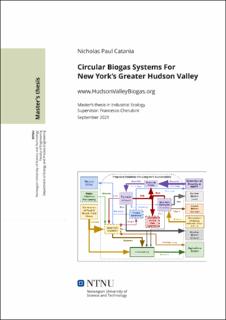| dc.description.abstract | New York State (NYS) has made great legislative strides in regards to climate change mitigation, excess food waste generation, and the renewable energy transition. Specifically, the NY Climate Act, the Food Donation & Food Scraps Recycling Law, and the introduction of the NY Low Carbon Fuel Standard have been key to introducing and adopting these initiatives. Biogas and other forms of renewable bioenergy will play an important role in New York State’s transition to a circular economy, yet there are many uncertainties regarding the most efficient and sustainable constructs of an integrated system design. By combining a series of technologies related to anaerobic digestion (as well as pyrolysis) and cross-referencing these with locally available feedstocks and existing infrastructures, new and innovative system designs can be formulated to create localized circular production cycles while offering a series of solutions strategically aligned with a food-energy-waste-nexus. Success of these initiatives relative to sustainability, environmental justice, and workforce development, is highly dependent on capacity building efforts between stakeholders and the environment. The strength of these interdependencies is paramount to developing resilient and long-lasting business practices that maximize impact with credible, measurable claims and catalyze further investment.
This report offers 10 circular biogas production system designs for the greater Hudson Valley which covers an area extending from the northern limits of New York City and up through the capital district. In consideration of the excess food waste legislative stipulation that requires all NYS DEC identified generators to divert their organics to beneficial use if they are within 25-miles of a respective recycling facility, each proposal is located approximately 25- to 50-miles from each to offer networked regional coverage. (Some overlap is intended to facilitate collection and transportation logistics.) The resulting radial coverage spans the majority of the 11 NY counties selected for this study and suggests corresponding infrastructure investments in 8 of them including Albany, Delaware, Dutchess, Orange, Rockland, Sullivan, Ulster, and Westchester. Special attention has been given to the state’s identified environmental justice regions in an effort to develop these systems with relevant humanitarian programs that can educate local residents on the opportunities and economical benefits available through conscious recycling efforts and systems thinking. The proposed installations will help to revitalize impoverished regions of NYS while creating green jobs and setting the necessary foundations for scaling innovative circular economy initiatives. These investments are necessary for long-term growth, increasing the workforce skills of citizens, and facilitating sustainable solutions for the greater Hudson Valley.
Presented herein is a regional plan of action and instructional outline designed to serve as a foundation for public engagement and implementation. The 10 proposed systems are as follows; 1) Monticello Transfer Station, 2) Taylor-Montgomery LLC, 3) Beacon Recycling & Transfer, 4) WeCare Denali | Rockland County, 5) Ulster County Resource Recovery Agency, 6) Delaware County Solid Waste Management Center, 7) Westchester County Wastewater Treatment Plant, 8) Wheelabrator Westchester, 9) Dutchess County Resource Recovery Agency, and 10) Town Of Colonie Landfill. Each integrated technological design offers innovative solutions that are iconic representations of circular production systems and treat available resources as high value materials for upcycle. Overall, this initiative will help NYS transition from its outdated linear business practices to more sustainable solutions that align with current legislative initiatives and meet the evolving and necessary demands of a low-carbon future. Each component plays an indicative and strategic role in the greater mission of achieving international sustainability, and these precedents can be scaled and replicated across the state, country, and world to truly empower the people, planet, and prosperity. | |
